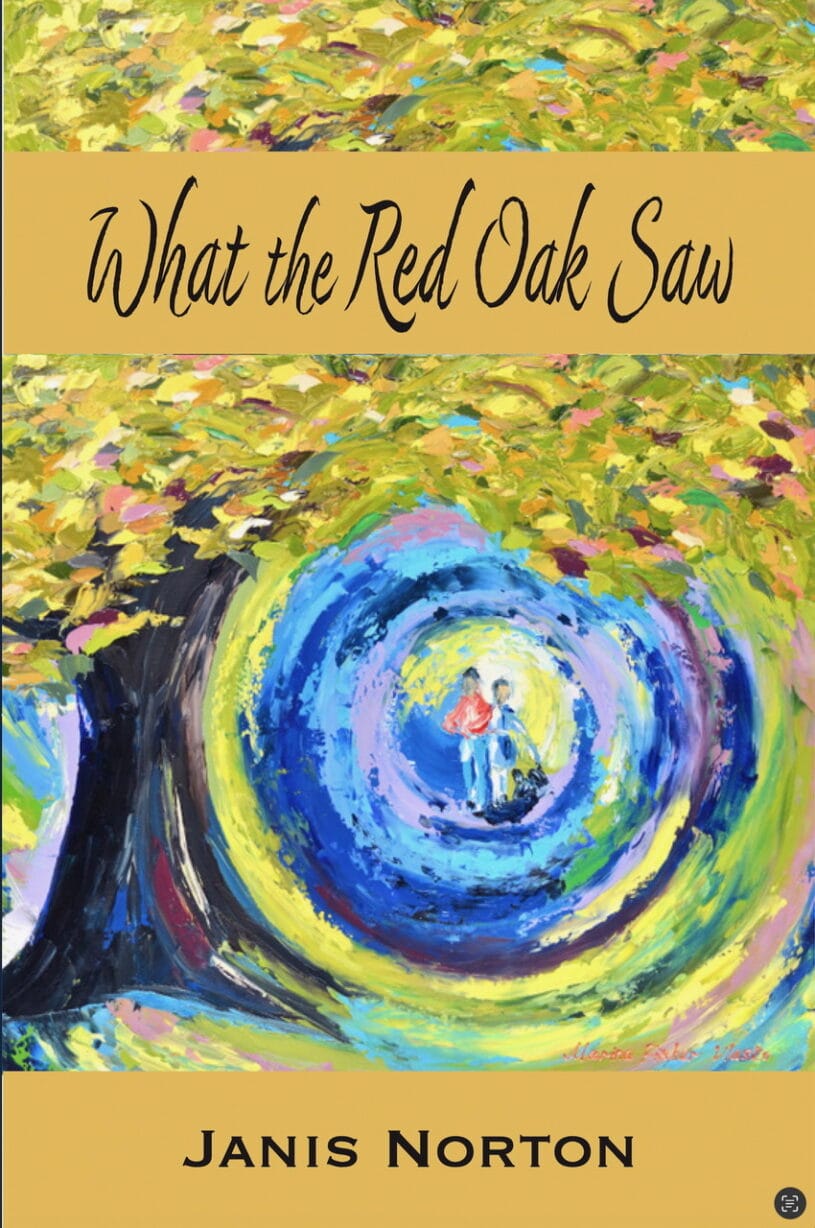By Mary Ann Zehr, contributor
A monthly column in 2025 by a local teacher and reader about connecting with books and taking in Harrisonburg’s literary scene.
~ Norton, Janis. What the Red Oak Saw. Moonshine Cove Publishing, 2025 ~

I have fond memories of camping and hiking in Shenandoah National Park going back to when I was in my 30s living in the nation’s capital, seeking respite in nature from my densely populated neighborhood. On one visit to the park, I came across stones from a chimney and the foundation of a dwelling. I didn’t give these ruins a second thought.
However, since I moved to Harrisonburg in 2018, I have been made aware by the work of an academic, a playwright, and a novelist that the remnants of the dwelling that I saw in the woods were left by people who were likely forced to abandon their home.
The academic–Katrina M. Powell, a Virginia Tech English professor, wrote The Anguish of Displacement and edited a collection of letters written by mountain families. They are books that document actions federal and state agencies took to remove 500 families from their homes in the 1930s after the park’s boundaries were drawn. The letters illustrate the tedium of the policies that impacted the mountain families after their removal. The families had to seek permission for activities such as collecting dead wood on land that they had previously owned.
The playwright, John Glick, a doctor who interacted with displaced mountain families in Elkton, Virginia, evoked my sympathies for their losses with “Can’t Feel at Home.” His play has been performed to packed-out audiences in Harrisonburg’s Court Square Theater for several seasons since its debut in 2022.
And now, Janis Norton, a Harrisonburg social worker, has written a debut novel, What the Red Oak Saw, about the displacement of mountain people to make the park. Moonshine Cove Publishing released Norton’s novel in June. In 2021, the same press published Across the Blue Ridge Mountains, by M.S. Marangione, a novel that also depicts the way of life of the mountain people that was upended by the creation of the park.
As the title of What The Red Oak Saw suggests, a red oak tree is a central character. The tree witnesses how Annie and Patrick Cleary–a young Catholic couple from Ireland–create a home and farm in the Blue Ridge Mountains and pass their appreciation for place onto several generations of family.
The novel begins with a prologue set in 1630 written from the perspective of the red oak. The story is fast-forwarded to the mid-1800s, when Annie and Patrick begin to cultivate land in Rockfish Gap, Virginia. Initially, they rent land but they soon buy the same plot.
Tree Communication
The red oak tree is distinctive because it has a large burl on its trunk. It sometimes pulses in a way that causes humans to wonder if it might be trying to communicate something. This isn’t as far-fetched as it may seem; after all, Peter Wohlleben wrote a nonfiction bestseller, The Hidden Life of Trees: What They Feel, How They Communicate–Discoveries from a Secret World. The red oak in the novel pulses when emotions are running high in the family, such as when Patrick is taking refuge by the tree while Annie is inside their cabin giving birth.
Only certain family members who are sensitive to the whisperings of nature can feel the pulsing of the tree. Annie has no special connection to the tree but Patrick, influenced by his Irish mother’s belief in fairies, does: “He placed both hands on the tree trunk and asked for a blessing on the crops. He was arrested by the sensation in his hands. There it was again, that light rhythmic pulsing.”
The families living in Rockfish Gap are quite isolated, though they occasionally visit Harrisonburg or Staunton to buy supplies. Sometimes they are affected by the broader events of the day, such as the Civil War. A reluctant fighter, Patrick is obliged to become a Confederate soldier and his wife and three children make do on the farm in a similar way that Ada does in Charles Frazier’s 1997 novel, Cold Mountain, when she is separated from the man she loves during the Civil War.
Annie and the children are shocked upon Patrick’s return to see how much Patrick’s health has been diminished. I cried at the novelist’s description of Annie sizing up her husband’s battered body.
Several generations of Clearys work the land in Rockfish Gap. I particularly enjoyed the part of the novel set in the 1900s of the Clearys learning how to make a farm in Virginia viable and maintain a household. As a modern reader, I admire mountain people’s skills of making apple butter, shucking corn, or putting a roof on a home.
The Clearys care about each other and their neighbors, but they struggle to share their true thoughts and feelings. Some characters are resolute, but others are not deliberate about their life choices, partnering up with whoever seems to be around and falling into jobs that don’t suit them provided by parents or in-laws.
The big red oak tree sees it all and even sometimes intervenes as best it can with action from its limbs.
Displacement

I like how the novelist lingers over the day-to-day efforts of the Clearys to establish a sense of place. I then share with the characters a feeling of outrage when on page 182 of the 368-page novel, the Clearys receive a letter from the state saying they will need to abandon their home because Shenandoah National Park has come into being.
The Clearys talk resistance to the government, but like other families in their community–even those who hire expensive lawyers–they are relocated to a government-issue house in Elkton. Norton’s depiction of the Clearys after displacement–from 1935 to 1974–shows they must quickly adapt to town jobs and activities as a means of survival.
The Cleary family doesn’t completely lose touch with their mountain life. While they’ve lost their land, they have official rights to visit and maintain the family graveyard. Some family members even visit the old red oak tree.
I wonder if this is true of some of the descendants of the real families who were displaced. Do they go back inside the park to visit graveyards or properties that were owned by their ancestors?
The novel tells an all-too-common story of how a vision to benefit some people is carried out by unjust means that impact the lives of other people. We owe it to the mountain people and descendants who lost their communities when the Shenandoah National Park was created to acknowledge their displacement.
Thanks for reading The Citizen, which won the Virginia Press Association’s 2022 News Sweepstakes award as the top online news site in Virginia. We’re independent. We’re local. We pay our contributors, and the money you give goes directly to the reporting. No overhead. No printing costs. Just facts, stories and context. We value your support.













